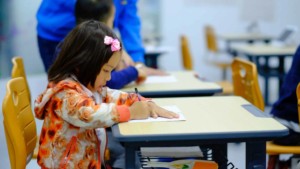Idea Economy Needs Better Prepared Students
We live in an idea economy, where a compelling premise can become an industry. Microsoft was the idea that computers could make us more productive. Google was the idea that search could be better. Wal-Mart was the idea that retail could be more efficient. eBay was the idea that the web could be a marketplace. K¹² was the idea that schools could be online. Each of these ideas attracted investment, created jobs, and launched an industry segment.
This idea economy runs on an engine of innovation and is particularly strong in America. As a result of several factors: a culture of independent thinking, financial markets and a venture capital sector adept at taking ideas to scale, and a strong, rich and diverse higher education sector, and a non-corrupt bureaucracy.
The idea economy is, to quote Richard Florida, “spiky.” It develops in clusters where smart people gather, where investment flows to a compelling premise, where cultural opportunities are rich. These smart clusters often have a theme: biotech in Boston, Music in Nashville, web 2.0 in the Bay Area. A significant cluster of e-learning companies has developed in the Washington-Baltimore area including Blackboard, K¹², Connections Academy, Sylvan, and Kaplan.
The idea economy is not an equal opportunity employer. Opportunity is clustered by geography and even more so by skill level. There are two growth economies in America—the idea economy and the service economy. Professional and technical jobs plugged in to the global economy will continue to grow in number. These jobs require a college degree and can be quite lucrative but with occasional dislocation. At the other end of the pay scale are the services and helping professions including landscaper, waiter, cook, and health care aids. These jobs earn less than the median income—often minimum wage—and do not require a college degree. It’s increasingly difficult to raise a family on a service economy wage. Between the two growth sectors, middle class jobs—the ones that created two-car-garage suburban American—are disappearing.
Learning is the entry ticket to the idea economy. “Most jobs that will have good prospects in the future will be complicated,” says Louis Gerstner, former CEO of IBM. “They will involve being able to juggle data, symbols, computer programs in some way or the other. To do this, workers will need to be educated and often retrained.”
The idea economy has two big implications for U.S. K-12 education. First, President Obama is right, we need a lot more college and career ready graduates. The 2009 McKinsey achievement gap study indicated that the under-education of American youth cost more than $1 trillion—the equivalent of a permanent recession with massive “economic dead zones.” We will always have a service economy, but we can shift the proportion of the U.S. population that contributes to the idea economy by improving our educational outcomes.
And second, students need idea economy preparation—what the Hewlett Foundation calls deeper learning—young people that can think critically and solve complex problems, work collaboratively, communicate effectively, and keep learning.
The ‘new normal’ of state fiscal constraints makes the increased demand for more college and career ready grads a new kind of challenge, what former West Virginia governor Bob Wise calls education’s GM moment—the need to do more for less. It sounds difficult to dramatically increase achievement and do it without spending more money, but it looks like it may be possible.
One emerging capability that is helping to meet the challenge is the rich informal learning ecosystem (Wikipedia, search, peer-to-peer, Khan Academy, etc.) that is surrounding the formal education system. As Curtis Bonk pointed out in The World is Open, it’s now possible for anyone to learn anything from anywhere.
Schools that blend the best of online learning and onsite support have the potential to customize learning for every student, to boost motivation, and double academic time on task—and do it without spending more. Building blended models and supporting their adoption will take some investment. But kids aren’t waiting for us; where states allow it, students are taking online courses and blending their own education.
The Digital Learning Now report is a blueprint for the blended learning future—state policies that fully embrace personal digital learning and make it more likely that students will be well served. Legislators in Florida, Utah, and Idaho are considering adoption of big chunks of the Digital Learning agenda. Is your state building a policy framework that will prepare kids for the idea economy?





0 Comments
Leave a Comment
Your email address will not be published. All fields are required.